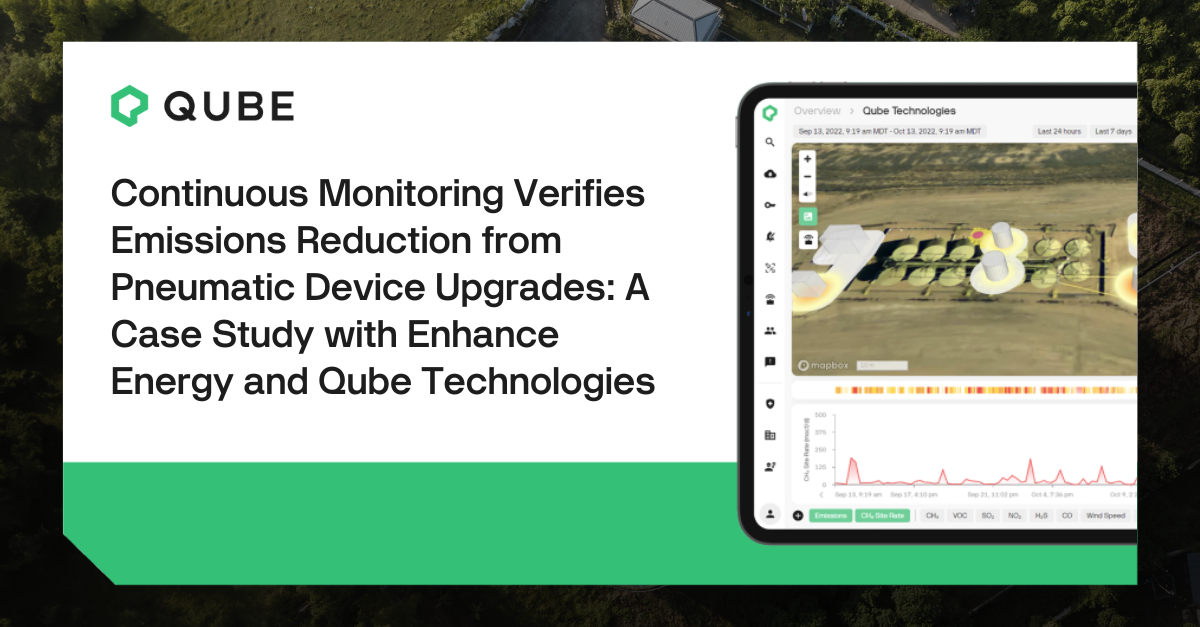
Expert Industry Insights
Get unique insights from Qube Technologies' experts to make better decisions and foster innovation.
Driving Leak Detection in RNG: Case Studies from Early Deployments with Maas Energy Works
In August 2024, Maas Energy Works piloted Qube’s continuous methane monitoring at a dairy digester and saw immediate gains in leak detection and repair. On the strength of those results, Maas rolled out Qube at 24 additional digesters across California, Texas, and Idaho.
Here we present three case studies showcasing the early success of the expanded deployments. These results demonstrate Qube’s strong success in RNG, with rapid detection, verified emissions cuts, and measurable increases in retained product.
Qube’s Continuous Monitoring Uncovers Blocked Vent Line: Emissions Drop 80% at Colorado Wellsite
At a Colorado wellsite, Qube’s continuous monitoring system alerted operators to a sustained emission event. Qube’s data localized the emissions to the tank area and prompted a field investigation to verify the source of the anomaly. With this information, the team was able to identify the emission source and interrogate the root cause, a blocked vent line leading to the combustor.
Rapid Leak Detection in the Piceance Basin: How Qube Helped Catch A Separator Leak
In Colorado’s Piceance Basin, a leading operator continues to set the bar for emissions control and operational safety. By integrating Qube Technologies’ continuous methane monitoring system, the operator aimed to strengthen its LDAR program and protect nearby homes located within 1,000 feet of its well pad.
This case study details how real-time alarms and accurate emissions source localization led to rapid action at the wellsite. Notably, catching a high-volume leak at the separator from going unnoticed over the weekend.
How Qube’s Automated Alarms Caught a Cow at the Wellsite
A Colorado operator using Qube’s continuous methane monitoring system received an automated alert about an unexpected emissions spike at a wellhead. Upon investigation, the field team discovered the source: a cow had rubbed against the equipment and opened a manual ball valve, unintentionally releasing gas. The team quickly shut the valve, restored normal readings, and installed fencing to prevent similar incidents. Thanks to Qube’s real-time alerts, the issue was resolved within an hour—without downtime or emissions escalation.
QB Energy and Qube Technologies Resolve Thief Hatch Leak Leading to 97% Emissions Reduction
“Another Win for Continuous Monitoring”
-Air Compliance Manager-QB Energy
Missed by AVO, caught by continuous monitoring. When Qube Technologies flagged elevated methane at a QB Energy tank site, field teams were able to locate and fix a leaking thief hatch—achieving a 97% emissions drop in hours. This case study shows how real-time continuous monitoring data and a fast response can keep operations running smooth.
How Qube Helped One Permian Operator Detect Offsite Emissions
Qube Technologies’ continuous emissions monitoring solutions provide operators with the tools to differentiate offsite from onsite emissions. Furthermore, our data modeling and intuitive dashboard omit those outside emissions from your facility total.
Pioneering Methane Monitoring: How Qube Technologies’ Unique Controlled Release Test Facility (CRTF) Drives Real-World Precision
Qube Technologies has built the Controlled Release Test Facility (CRTF), roughly 60 km (~ 37 mi) west of Calgary, Alberta, which functions as a specialized field environment to conduct continuous monitoring (CM) emissions tests under controlled real-world conditions.
Interrogating Emissions Using the Qube Platform
Qube’s platform provides continuous emissions monitoring, using wind data, gas concentration, and source identification algorithms to detect methane leaks. However, users must verify alerts, as the algorithm benefits from operational input to ensure accurate source identification.
Continuous Monitoring Verifies Emissions Reduction from Pneumatic Device Upgrades: A Case Study with Enhance Energy and Qube Technologies
By upgrading high-bleed pneumatic devices to low-bleed controllers and implementing robust monitoring programs, operators can achieve significant reductions in methane emissions. These proactive measures are essential for complying with evolving regulations and minimizing environmental impact.
How Qube Technologies’ Methane Sensors Achieve Reliable Accuracy in Long-Term Deployments
This study reinforces a core value proposition of the Qube platform: minimal sensing hardware is required to accurately quantify methane emissions, and the devices remain reliable year after year in the field without manual intervention.
Using Continuous Monitoring to Detect Incomplete Combustion and Reduce Emissions
Qube deployed continuous monitoring devices with CH4 and CO sensors throughout a customer’s natural gas processing facility. The Qube sensors detected elevated emissions – specifically, increased CO concentrations – and reported this data to the customer via Qube’s dashboard.
Understanding Intermittent Emissions and How CM Technology Fills the Gaps
Emissions from oil and gas facilities are dynamic and often intermittent, meaning that standard measurement techniques may only capture a small portion of a facility's actual emissions. This is commonly known as intermittency, referring to the sporadic release of gases caused by operational changes or equipment issues.
How Continuous Monitoring Maximized the Value of Biogas for Roeslein Alternative Energy
This pilot showed that leaks do not occur at consistent intervals or emission rates. In fact, just 5% of the detected leaks represented ~55% of the total emissions over nine months of data collection. This distribution is similar to the oil and gas sector, where research has found that the top 5-10% of leaks represent 60-80% of emissions.
White Paper: Reducing methane emissions: Implementing data science informed operation and maintenance work practices using continuous monitoring technology (abstract)
Continuous monitoring technologies allow operators to implement novel operation and maintenance work practices to efficiently respond to methane emissions
Geothermal power plant emissions detection
One of the largest power producers in Indonesia implemented Qube‘s continuous monitoring solution to monitor for H2S gas at a new geothermal facility.















